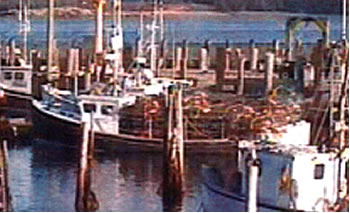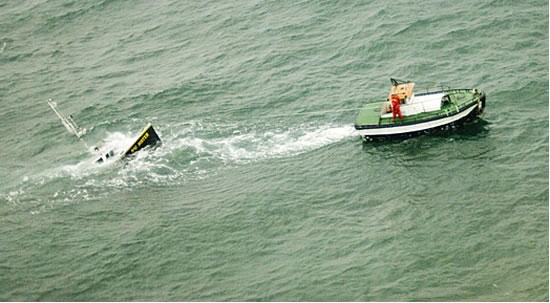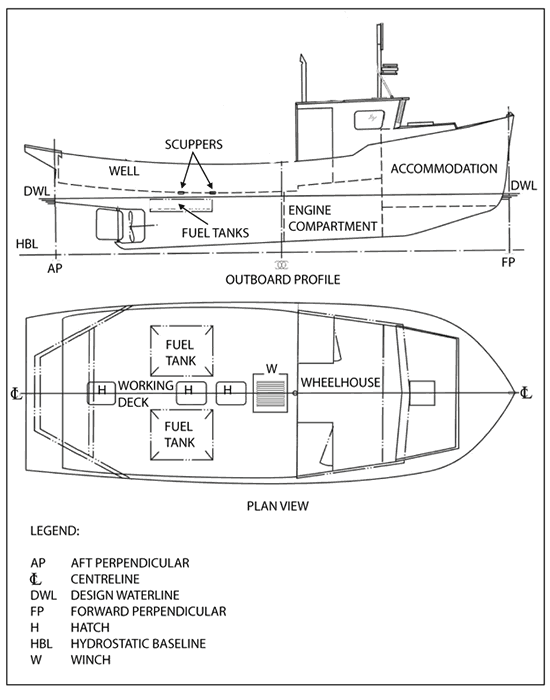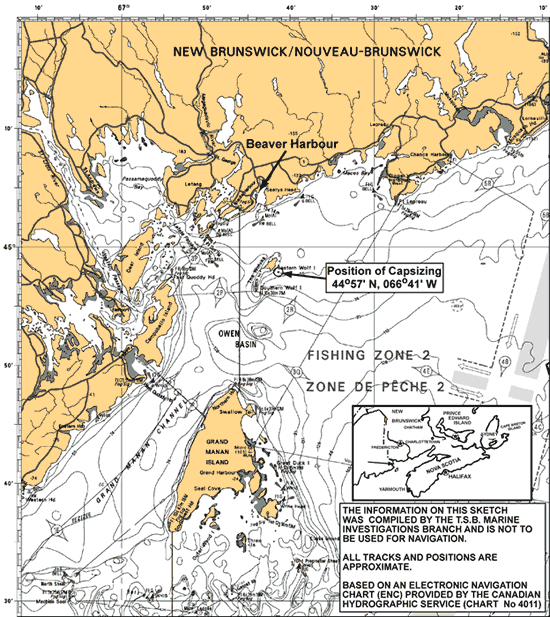Capsizing with loss of life
Small fishing vessel Big Sister
Bay of Fundy, New Brunswick
The Transportation Safety Board of Canada (TSB) investigated this occurrence for the purpose of advancing transportation safety. It is not the function of the Board to assign fault or determine civil or criminal liability. This report is not created for use in the context of legal, disciplinary or other proceedings. See Ownership and use of content. Masculine pronouns and position titles may be used to signify all genders to comply with the Canadian Transportation Accident Investigation and Safety Board Act (S.C. 1989, c. 3).
Summary
On the morning of 13 November 2007, at 0605 Atlantic standard time, the small fishing vessel Big Sister, with the owner and three crew members on board, departed Beaver Harbour, New Brunswick, laden with lobster traps. After being underway for about 45 minutes, the crew began to set the traps, at which point they noticed water on deck. The vessel capsized shortly thereafter. The three crew members were rescued by another fishing vessel. The body of the owner was recovered later.
Factual information
Particulars of the vessel
| Name | Big Sister |
|---|---|
| Official number | 812731 |
| Port of registry | Yarmouth, Nova Scotia |
| Flag | Canada |
| Type | Small fishing vessel |
| Gross tonnage | 10.54 |
| LengthFootnote 1 | 10.7 m |
| Built | 1989, Barrington Passage, Nova Scotia |
| Propulsion | One 136 kW diesel engine |
| Cargo | Approximately 140 lobster traps |
| Crew | 4 |
| Registered owner | Private owner, Beaver Harbour, New Brunswick |
Description of the vessel
The Big Sister was a small fishing vessel of the Cape Island design of open construction, built in moulded, glass-reinforced plastic, with the wheelhouse and accommodation forward, and the engine compartment beneath the wheelhouse. The working deck was aft, surrounded by a solid bulwark forming a well. An extension placed beyond the limits of the stern and flush with the top of the bulwarks was used to store fishing gear. Entry to the wheelhouse was through a hinged door on the starboard side, and access to the engine compartment was through a large hatch cover located in the wheelhouse. No watertight bulkhead was fitted below deck, nor was one required (see Appendix A).
The vessel did not have a bilge high level detection system, nor was one required. The only mechanical equipment on deck was a trap hauler. The working deck had three flush non-watertight hatches located along the centreline; these provided access to the below-deck space in way of the steering gear, the fuel oil tanks, and the manual bilge pump. Two scuppers were located in the bulwark at deck level on each side.
History of the voyage
At 0605Footnote 2 on 13 November 2007, the Big Sister, with the owner at the helm and three crew members on board, departed Beaver Harbour, New Brunswick (N.B.), for a seven-mile transit to a group of islands known as "the Wolves" in the Bay of Fundy, N.B. (see Appendix B). Before departure, the scupper plugs had been set in place due to the limited freeboard that was approximately 30 inches (0.763 m) between the waterline and the top of the gunwales. The vessel was laden with about 140 lobster traps weighing about 27 kg each, with the intention of setting the traps for the opening day of the lobster season. The traps had been loaded in tiers five high, five wide, and five long. In addition, 10 traps sat on the stern extension, with 4 more by the wheelhouse door.
After being underway for about 45 minutes in choppy seas, and with the wind blowing on the vessel's port beam, the crew began setting the traps in pairs. After setting seven or eight pairs of traps from the forward-most tier, the vessel's deck became visible. At this time, the crew member setting the traps noticed water on the deck and alerted the owner. The owner immediately transmitted a distress call on VHF radiotelephone Channel 16, switched on the bilge pump, and went down into the accommodation to retrieve personal flotation devices (PFDs).
As the vessel rapidly rolled to port, one crew member on deck attempted to don a PFD, but was unable to do so before going overboard. The owner and two other crew members were in the wheelhouse. One of the crew members also attempted to don his PFD, but was unable to, at which point he hung onto his PFD, exited the wheelhouse, and jumped over the side. Once the vessel capsized, the other crew member exited through a window, but the owner was unable to do so (and remained inside). The vessel capsized in position 44°57′55″ N, 066°41′25″ W.
Once clear of the vessel, the three crew members - none of whom had managed to don a PFD - held onto debris for flotation. Another small fishing vessel, the Makala Marie, having heard the distress call on the VHF, arrived on scene about 20 minutes later and retrieved the three crew members from the water. While they were being taken ashore, a herring seiner and its skiff arrived on scene. The skiff began towing the partially submerged Big Sister (which had partially righted itself) toward shallow waterFootnote 3 and, as this was being done, the body of the owner emerged from the wheelhouse. The body was brought on board the skiff and, although cardiopulmonary resuscitation (CPR) was administered, resuscitation efforts were unsuccessful.
Vessel certification and stability
As a small fishing vessel not exceeding 15 in gross tonnage, the Big Sister was subject to Part II of the Small Fishing Vessel Inspection Regulations (SFVIR), and as such did not require any inspection by Transport Canada, nor had such an inspection been performed. Furthermore, the vessel was not required to submit any stability data for approval.
However, even though no data were available, TSB's post-occurrence stability analysis referenced a similar vesselFootnote 4 such that it was possible to derive the lightship characteristics of the Big Sister, while nonetheless taking into consideration the minor differences between the two vessels. The Big Sister's stability characteristics were also established for its departure condition from Beaver Harbour, and again at the time of the occurrence, based on the number of crew members and their personal effects, the estimated consumables, and the fishing gear on board.
No previous indications of vessel leakage/structural failure had been reported. In 2004, the vessel underwent a general examination afloat for insurance purposes in Beaver Harbour, and was found to be in a good condition.
Lifesaving equipment
Although PFDs were carried on board, they were not worn by the crew at the time of the occurrence. In addition, the Big Sister carried neither a liferaft nor an emergency position indicating radio beacon (EPIRB), nor were these required by regulation. There was a sufficient number of lifejackets and PFDs for the crew complement. Also, the 2004 insurance evaluation noted one immersion suit.
Personnel certification and experience
The owner had over 20 years' experience on fishing vessels, and two of the crew had over 12 years' experience. The other crew member had never been a full-time fisher, but had served as a deckhand on the Big Sister on two prior occasions. Neither the owner nor any crew members held a certificate of competency or had taken marine emergency duties (MED) training, nor were there any requirements to do so.
Weather
Environment Canada had forecast temperatures of 5°C with southerly winds of 15 to 20 knots, shifting to northwest 20 knots by the afternoon.
The closest Environment Canada weather recording site, Pointe Lepreau, N.B., recorded wind speeds of 13 knots.Footnote 5 The actual winds at the time of the occurrence were estimated by those on scene to be 20 to 25 knots from the southwest, with seas estimated at 1 m to 2 m. The sea temperature was about 10°C.
Analysis
Vessel stability and capsizing
Because the vessel was not recovered, the TSB was unable to confirm the specific cause of the capsizing. Shortly before the event, however, the captain transmitted a distress call after being informed of water on deck. Such a reaction suggests a significant amount of water ingress. Only two sources for this can be reasonably assumed: a leak below the waterline, or water coming over the gunwales and flooding the vessel.
Of these assumptions, the second is more likely, partly because there had been no previous reports of vessel leakage/structural failure, but also due to the already low freeboard, the choppy seas, the fact that the hatches on the working deck were not watertight, and the number and position of lobster traps on deck (which would have made it difficult to detect the water being held in by the plugged scuppers).
For this reason, when the TSB's post-occurrence stability analysis prepared conditions to reflect the loading of the vessel upon departure from Beaver Harbour and at the time of the occurrence, various levels of flooding in the well were simulated, as well as the effect of wind and waves. Vessel stability was then assessed and compared against the STAB 4 stability standards.Footnote 6
In its departure condition, the vessel's stability was such that the metacentric height (GM) was very large, and the area under the righting arm (GZ) curve at an angle of heel between 0° and the angle of downflooding exceeded the STAB 4 criteria. However, the range of positive stability was limited to about 19° (corresponding to the angle of downflooding) due to the submergence of the gunwale at that angle. Although STAB 4 offers no explicit criterion for a minimum range of positive stability, there is a criterion for the area under the GZ curve between 30° and 40°. This was not met. Furthermore, in departure condition, the freeboard to the gunwale was limited to 0.763 m.
Once various amounts of well flooding were factored in, the TSB simulations showed a significant decrease in the GM value due to large free surface effect, along with a rapid reduction in area under the GZ curve and the corresponding stability reserve. Ultimately, the GM would have become negative once the flooding reached 10 to 15 per cent of the well's capacity, and the vessel would loll up to 10°. Beyond that point, up to the angle of downflooding, the area under the GZ curve would be minimal. However, in a dynamic environment, and with the added effect of wind and waves, the vessel would have capsized.
Requirement for stability data
There is no requirement for small uninspected fishing vessels, such as the Big Sister, to submit trim and stability data to Transport Canada for information, review, or approval. Although Transport Canada is reviewing this requirement under the proposed Fishing Vessel Safety Regulations pursuant to the Canada Shipping Act, 2001, these proposed regulations are not expected to be published in the Canada Gazette, Part I, before autumn 2009.
The Board has repeatedly expressed the concern that the stability characteristics of most small fishing vessels are not formally assessed and, consequently, that their safe operation is compromised when vessels that have inadequate stability characteristics continue to be in service. In November 2003, the Board issued two recommendations to Transport Canada (M03-05 and M03-06), calling for the assessment/verification of stability for new and existing small inspected fishing vessels. In 2005, following the loss of the Ryan's Commander and concerned that, in the absence of meaningful action to address previous recommendations, fishers continued to be placed at undue risk, the Board issued another recommendation (M05-04) calling on Transport Canada to immediately implement recommendations M03-05 and M03-06.
In response, Transport Canada established an interim policy for determining, based on a list of risk factors, whether a small inspected fishing vessel requires a stability booklet.Footnote 7 Transport Canada also issued Ship Safety Bulletin 04/2006, Safety of Small Fishing Vessels: Information to Owners/Masters about Stability Booklets. The bulletin, which applies to fishing vessels between 15 and 150 in gross tonnage and not more than 24.4 m in length, outlines the process that vessel owners and operators must follow to determine if their vessel requires a stability booklet and how to obtain one.
In 2008, the TSB reassessed Transport Canada's responses to Board Recommendations M03-05, M03-06, and M03-04. Although the responses to each were found to be fully satisfactory, it was noted that TSB marine staff will continue to monitor the implementation of interim measures before the coming into force of the new Fishing Vessel Safety Regulations.
While recommendations M03-05 and M03-06 were made in relation to small inspected fishing vessels (with a gross tonnage over 15 but not over 150), the principles also apply to small uninspected fishing vessels (not exceeding 15 in gross tonnage) given that the risk associated with their operation is similarly high.
In this regard, Transport Canada mailed Ship Safety Bulletin 04/2006 to owners of fishing vessels of 15 gross tons or less. Recipients were encouraged to determine if a stability booklet would be beneficial in operating their vessels safely.
Therefore, without a formal assessment of the stability characteristics of small fishing vessels, their safe operation may be compromised and fishers may continue to be placed at undue risk.
Use of personal flotation devices (PFDs)
Lifejackets were designed and developed to provide buoyancy and, in the case of injury, keep an unconscious wearer's head face up and above the surface. The PFD, on the other hand, was developed to provide some degree of flotation should the wearer fall in the water inadvertently. Although it does not keep a wearer's face clear of the water, it keeps users afloat and, in addition, it is more likely to be worn than the less comfortable lifejacket.
Despite improvements in the manufacture of PFDs (including inflatable versions and those equipped with flotation collars), many fishers are nonetheless reluctant to wear them, considering them cumbersome and uncomfortable. Others are concerned that PFDs will get caught in gear.
Although Transport Canada encourages the wearing of PFDs, and the proposed regulatory reform to the Canada Shipping Act, 2001 addresses the issue of wearing them in an open boat or while on deck, the current proposalFootnote 8 states that PFDs need only be worn under conditions where there is a perceived increase in the risk of drowning and that lifejackets are to be "readily available." When small fishing vessels capsize, however, they tend to do so quickly. This can often preclude the retrieval of PFDs or lifejackets from stowage areas, which increases the risk of not wearing PFDs.
Along with thermal protection, buoyancy is a critical factor for maximizing survival time. In this occurrence, despite choppy seas, none of those involved had been wearing PFDs. No crew members were able to don their lifejackets or PFDs before entering the water.
It is important that fishers be aware of the necessity of wearing PFDs when working in conditions that warrant their use, and that lifejackets be available in close proximity to working locations. Failure to do so not only deprives fishers of buoyancy in the event of a forced abandonment, but retrieving and donning lifejackets or PFDs can take up valuable time in an emergency.
Bilge high level detection system
The installation of a bilge high level detection system is an inexpensive way to detect flooding before a vessel's stability is compromised. Such a system announces the need to search for and repair the source of any water ingress. Even in instances where ingress cannot be stopped or controlled, early detection allows more time to prepare to abandon ship, thereby increasing a crew's chances of survival.
In this occurrence, a detection system, if fitted, would have given the operator and crew early warning of water ingress in the bilge. Such a system, however, is not required for small fishing vessels such as the Big Sister, nor had the owner installed one. Previous TSB reports have recognized the risks that this poses.Footnote 9 Elsewhere, the Workers' Compensation Board of British Columbia (now called WorkSafe BC) already requires all commercial fishers to install a bilge high water level detector in the engine compartment and lazarette of their vessel, and to have these connected to an alarm system.
Currently, Transport Canada is also reviewing the carriage of bilge high level alarms under the proposed Fishing Vessel Safety Regulations pursuant to the Canada Shipping Act, 2001.
In this occurrence, the lack of information about water ingress deprived the crew of timely information essential to initiating appropriate action.
Crew knowledge and training
Generally, few fishers fully understand the principles of ship stability - in particular, as in this occurrence, the effects of a large, heavy load stacked high on the deck with a minimal freeboard. As a result, occurrences such as this continue to happen. To mitigate this, stability education and evaluation courses - structured, for example, toward acquiring a certificate of competencyFootnote 10 - would raise fishers' awareness of the cumulative nature of the factors that can compromise vessel stability.
In this occurrence, despite over 20 years' experience on fishing vessels, the owner had no formal training in seamanship, stability, or MED. Although there was no requirement for this per se, formal training and experience can nonetheless provide an enhanced awareness of safe practices during normal and emergency operations. Crews that are unaware of the stability characteristics of their vessel and the general principles involved may unknowingly place themselves and their vessels at undue risk.
Findings
Findings as to causes and contributing factors
- The weight and height of the lobster traps on deck, combined with the plugged scuppers, made the vessel vulnerable to any ingress of water.
- The flooding in the well created a large free surface effect and a negative metacentric height (GM), which, combined with low stability and the dynamic environment, caused the vessel to capsize.
- The lack of a bilge high level alarm deprived the crew of an early warning of water ingress.
Findings as to risk
- Failure to wear personal flotation devices (PFDs) or store them near work locations not only deprives fishers of buoyancy in the event of a forced abandonment, but retrieving and donning lifejackets or PFDs can take up valuable time in an emergency.
- Crews that are unaware of the stability characteristics of their vessel and the general principles involved may unknowingly place themselves and their vessels at undue risk.
- Without a formal assessment of the stability characteristics of small fishing vessels, their safe operation may be compromised and fishers may continue to be placed at undue risk when operating vessels with inadequate stability characteristics.
This report concludes the Transportation Safety Board's investigation into this occurrence. Consequently, the Board authorized the release of this report on .
Appendices
Appendix A - Outline arrangement of the vessel
Appendix B - Area of the occurrence
Appendix C - STAB 4 Stability Standards
STANDARD: STAB 4
STABILITY STANDARDS FOR FISHING VESSELS:
- subject to compliance with the Large Fishing Vessel Inspection Regulations, or
- required to submit stability data by the Small Fishing Vessel Inspection Regulations.
OPERATING CONDITIONS WITH NO ACCUMULATED ICE
- The following minimum intact stability criteria are to be used in the approval of stability data for the above vessels:
- The area under the righting lever (GZ) curve should not be less than 0.055 metre-radians up to Ø = 30° angle of heel, and not less than 0.09 metre-radians up to Ø = 40°, or the angle or downflooding Øf if this angle is less than 40°. Additionally, the area under the righting lever (GZ) curve between the angles of heel of 30° and 40° or between 30° and Øf if this angle is less than 40° should not be less than 0.03 metre-radians.
- The righting lever GZ should be at least 0.20 metres at an angle of heel equal to or greater than 30°.
- The maximum righting arm should occur at an angle of heel preferably exceeding 30° but not less than 25°.
- The initial metacentric height (GM) should not be less than 0.35 metres.
WORST OPERATING CONDITION WITH ACCUMULATED ICE
- Using the ice accumulation weights and vertical centres of gravity requires by the appropriate fishing vessel inspection regulations:
- The area under the righting lever (GZ) curve should not be less than 0.04 metre-radians up to 30 degrees angle of heel and not less than 0.058 metre-radians up to 40 degrees or the angle of downflooding if this angle is less than 40 degrees. Additionally, the area under the righting lever (GZ) curve between the angles of heel of 30 degrees and 40 degrees or between 30 degrees and the angle of downflooding, if this angle is less than 40 degrees, should not be less than 0.016 metre-radians.
- The righting lever (GZ) should be at least 0.15 metres at an angle of heel equal to or greater than 20 degrees.
- The maximum righting lever (GZ) should occur at an angle of heel not less than 20 degrees.
- The initial metacentric height (GM) should not be less than 0.23 metres.
- Hydrostatic and stability curves should normally be prepared on a designed trim basis. However, where the operating trim or the form and arrangement of the ship are such that change in trim has an appreciable effect on righting arms, such change of trim is to be taken into account.
- The calculations may take into account the volume to the upper surface of the deck sheathing, if fitted. In the case of wood ships the dimensions should be taken to the outside of hull and deck planking.
- Cross Curves of Stability may take the following into account and a note to this effect must be shown:
- Enclosed weathertight superstructures and enclosed weathertight deckhouses of similar construction,
- Weathertight trunks, and
- Hatchways having regard to the effectiveness of the closures.
- Definitions for paragraph 5 are as follows:
SUPERSTRUCTURE means a decked structure on the bulkhead deck extending from side to side of the ship, or with the side plating not being inboard of the shell plating more than 4 per cent of the maximum moulded breadth of the vessel measured at mid-ships. A raised quarter deck is regarded as a superstructure.
WEATHERTIGHT means that in any sea conditions water will not penetrate into the ship.
- In cases where a ship would flood through an opening, the stability curve is to be cut short at the corresponding angle of flooding and the ship is to be considered as having entirely lost her stability at that angle.
- In the calculations for loading conditions an allowance is to be made for the weight of the wet fishing nets and tackle.
- In all cases the cargo should be assumed to be homogenous unless this is inconsistent with practice.
- The following conditions are not considered as operating conditions. Therefore the above criteria are not applicable and the standard to be obtained in these conditions is a positive GM:
- Lightship
- Port after discharge of cargo with 10% of fuel, fresh water and stores remaining and accumulated ice on top-sides and rigging. (The lightship condition is defined as the condition of a vessel ready for sea with no stores, consumables, fluid ballast or crew on board).



